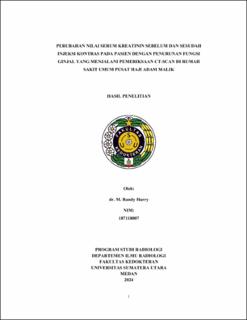Perubahan Nilai Serum Kreatinin Sebelum dan Sesudah Injeksi Kontras pada Pasien dengan Penurunan Fungsi Ginjal yang Menjalani Pemeriksaan CT-Scan di Rumah Sakit Umum Pusat Haji Adam Malik
Serum Creatinine Values after Contrast Injection in Patients with Impaired Kidney Function who Undergoing CT-Scan Examination at Adam Malik General Hospital

Date
2024Author
Harry, M Randy
Advisor(s)
Daulay, Elvita Rahmi
Tarigan, Radar Radius
Metadata
Show full item recordAbstract
One of the most commonly performed clinical examinations is imaging, which
aims to identify the anatomical structures of a specific organ or organ system, or
even evaluate its physiological changes through various specialized methods.
Computed tomography (CT)-scan is a diagnostic test that combines X-ray
capabilities and computer technology to produce images capable of visualizing
the inside of the body. In CT scans, the use of contrast serves as a chemical "dye"
to mark important areas to be evaluated both anatomically and physiologically,
and it is only performed with specific indications considering that the injected
substance is iodine-based, and it is reported to have several side effects. Acute
kidney injury (AKI) or acute kidney failure due to contrast is one of the most
common iatrogenic events encountered in everyday clinical practice. Serum
creatinine is one of the main biomarkers, where an increase of more than 1.5-1.9
times the normal threshold (or an increase of 0.3 mg/dL or ≥26.5 μmol/L) can be
diagnosed with AKI according to KDIGO (Kidney Disease Improving Global
Outcomes).
We present a study on the effects of contrast on changes in creatinine levels as a
biomarker, especially in patients with decreased kidney function. The increase in
serum creatinine can be effectively used as a biomarker to anticipate the occurrence of acute kidney injury (AKI) due to contrast agents, especially in
patients experiencing decreased kidney function.
Collections
- Master Theses [19]
